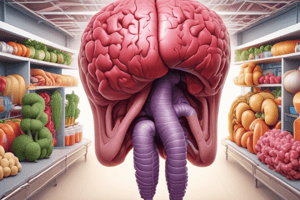Podcast
Questions and Answers
What role do bile salts play in the digestion process?
What role do bile salts play in the digestion process?
- They facilitate the absorption of water and electrolytes in the large intestine
- They aid in the breakdown of triglycerides into smaller fatty acids and monoglycerides (correct)
- They help in the synthesis of vitamin K in the large intestine
- They assist in the breakdown of proteins into amino acids
What is chyle?
What is chyle?
- The mixture of water, electrolytes, and undigested fibrous material
- The mixture of cholesterol and vitamin-soluble nutrients
- The waste products stored in the rectum before being excreted as feces
- The mixture of glucose, amino acids, fatty acids, and glycerol (correct)
Which of the following nutrients are absorbed in the large intestine?
Which of the following nutrients are absorbed in the large intestine?
- Water, electrolytes, vitamin K, and some vitamin B (correct)
- Fatty acids and monoglycerides
- Triglycerides and cholesterol
- Glucose and amino acids
What is the role of the circulatory system in the digestive process?
What is the role of the circulatory system in the digestive process?
Which statement best summarizes the function of the human digestive system?
Which statement best summarizes the function of the human digestive system?
Flashcards are hidden until you start studying
Study Notes
Human Digestive System
The human digestive system is responsible for breaking down food into nutrients that can be absorbed and used by our bodies. This process takes place through a series of organs working together. Here is an overview of how this complex system functions:
Digestion Process
Digestion begins when we eat food. Chewing mechanically breaks down the food particles, while saliva from the mouth contains enzymes such as amylase, which chemically start the digestion of carbohydrates. The food then moves down the esophagus into the stomach.
In the stomach, the partially digested food mixture is called chyme. Here, the stomach secretes gastric juices containing hydrochloric acid and pepsin, which break down proteins further. The gastric juices also help to kill bacteria and neutralize any acidic food particles.
The chyme then moves into the small intestine, where most of the digestion and absorption of nutrients takes place. The small intestine is lined with finger-like projections called villi, which increase the surface area for absorption. The pancreas, located behind the stomach, secretes enzymes such as amylase, proteases, and lipases to further break down carbohydrates, proteins, and fats, respectively.
Bile, a green, alkaline fluid produced by the liver and stored in the gallbladder, helps to emulsify fats and neutralize acids. The gallbladder contracts to release bile into the small intestine, where it mixes with the chyme. The bile salts in bile help break down the triglycerides into smaller fatty acids and monoglycerides, which are absorbed along with cholesterols and vitamin soluble nutrients. The resulting mixture of water, electrolytes, glucose, amino acids, fatty acids, and glycerol is called chyle.
The remaining waste products from digestion, such as undigested fibrous material, are passed into the large intestine. The large intestine absorbs water, electrolytes, vitamin K, and some vitamin B. The remaining waste products are stored in the rectum until they are passed out through the anus as feces.
Food Nutrient Absorption
The digestive system plays a vital role in providing nutrients necessary for growth, repair, and energy production. It breaks down food into simple molecules, such as glucose, amino acids, fatty acids, monoglycerides, cholesterol, vitamins, and minerals, which are absorbed into the bloodstream via a process called active transport. These absorbed nutrients are then delivered to cells throughout the body via the circulatory system.
In summary, the human digestive system efficiently breaks down food particles into simpler molecules that can be easily absorbed and utilized by our body's cells, ensuring proper growth, repair, energy production, and overall health maintenance.
Studying That Suits You
Use AI to generate personalized quizzes and flashcards to suit your learning preferences.



